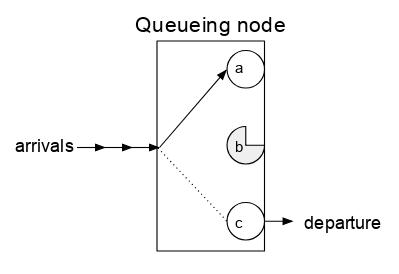Introduction
Therearealotoftangibleandintangiblequeuingorcrowdingphenomenaindailylife,suchasqueuesforticketpurchasesandbusylocaltelephonelines.Thebasicideaofqueuingtheorywasformedin1909byDanishmathematician,scientist,andengineerA.K.Erlangwhenhesolvedtheproblemofautomatictelephonedesign,whichwascalledthetraffictheoryatthattime.Inspiredbythethermodynamicsstatisticalbalancetheory,hesuccessfullyestablishedatelephonestatisticalbalancemodel,andderivedasetofrecursivestateequations,thusderivingthefamousErlangtelephonelossrateformula.
Sincethebeginningofthe20thcentury,telephonesystemdesignhasbeenapplyingthisformula.Inthe1930s,theSovietmathematicianA.Я.Xinchincalledthetelephonecallflowinstatisticalequilibriumthesimplestflow.SwedishmathematicianBalmintroducedconceptsanddefinitionssuchaslimitedaftereffectflow.Theyusedmathematicalmethodstoanalyzetheintrinsiccharacteristicsoftelephonecallsandpromotedthestudyofqueuingtheory.Intheearly1950s,Americanmathematicianresearchonbirthanddeathprocess,BritishmathematicianD.G.KendallputforwardtheembeddedMarkovchaintheory,andtheclassificationmethodofqueuingqueue,whichlaidthetheoreticalfoundationforqueuingtheory.Afterthis,L.Takakiandothersintroducedthecombinationmethodintoqueuingtheory,makingitmoresuitableforvarioustypesofqueuingproblems.Sincethe1970s,peoplehavebeguntostudyqueuingnetworksandtheasymptoticsolutionsofcomplexqueuingproblems,whichhavebecomeanewtrendinthestudyofmodernqueuingtheory.
Definition
queuingtheory,orstochasticservicesystemtheory,istoobtainthesequantitativeindicators(waitingtime,Queuelength,busyperiod,etc.),andthenimprovethestructureoftheservicesystemorreorganizetheserviceobjectsaccordingtotheselaws,sothattheservicesystemcannotonlymeettheneedsoftheserviceobjects,butalsomaketheorganization’sexpensesthemosteconomicalorSomeindicatorsareoptimal.Itisasub-disciplineofmathematicaloperationsresearchandadisciplinethatstudiestherandomlawofqueuingphenomenaintheservicesystem.Itiswidelyusedinarandomservicesystemforsharingvariousresourcessuchascomputernetworks,production,transportation,andinventory.Thecontentofqueuingtheoryresearchhasthreeaspects:statisticalinference,buildingmodelsbasedondata;systembehavior,thatis,theprobabilisticregularityofquantitativeindicatorsrelatedtoqueuing;systemoptimizationproblems.Itspurposeistocorrectlydesignandeffectivelyoperateeachservicesystemtomakeitplaythebestbenefit.
Thequeuingtheoryoriginatedfromtelephoneconversationsintheearly20thcentury.From1909to1920,theDanishmathematicianandelectricalengineerA.K.Erlangusedthemethodofprobabilitytheorytostudythetelephoneconversationproblem,thuscreatingthisappliedmathematicssubjectandestablishingmanybasicprinciplesforthissubject.Inthemid-1930s,whenW.Fellerintroducedthebirthanddeathprocess,queuingtheorywasrecognizedasanimportantsubjectinmathematics.DuringandafterWorldWarII,queuingtheorybecameanimportantcontentinthenewfieldofoperationsresearch.Intheearly1950s,D.G.Kendallmadeasystematicstudyofqueuingtheory.HeusedtheembeddedMarkovchainmethodtostudyqueuingtheory,whichledtofurtherdevelopmentofqueuingtheory.Itwashewhofirst(1951)usedthethree-lettersymbolX/Y/Ztorepresentaqueuingsystem.WhereXrepresentsthedistributionofcustomerarrivaltime,Yrepresentsthedistributionofservicetime,andZrepresentsthenumberofservicedesksintheserviceorganization.
1.Representationofqueuingmodel
X/Y/Z/A/B/C
X—customersarriveoneafteranotherThedistributionoftheintervaltime;
Y—thedistributionofservicetime(M—exponentialdistribution,D—definitetime,Ek—k-orderErlangdistribution,G—generalDistribution,etc.);
Z—numberofservicedesks;
A—systemcapacitylimit(defaultis∞);
B—numberofcustomersources(default∞);
C—Servicerule(thedefaultisfirstcomefirstservedFCFS).
2.Measurementindicatorsofthequeuingsystem
ServicecaptainLs—thenumberofcustomersbeingserved;
QueuelengthLq—thenumberofcustomerswaitinginthequeue;
TotalqueuelengthL=Ls+Lq—Thetotalnumberofcustomersinthesystem;
ServicetimeWs—Thetimeconsumedbycustomersinservice;
WaitingtimeWq—Thetimethecustomerwaitsinthequeue;

TotaltimeW=Ws+Wq—ThecustomerisinthesystemThetotalstaytime;
Busyperiod—thetimeintervalbetweentwoidletimesoftheserviceorganization;
Serviceintensityρ;
Steadystate—thesystemrunsforalongenoughtimeAfterthat,theinfluenceoftheinitialstatebasicallydisappears,andthesystemstatenolongerchangeswithtime.
3,Thecompositionandapplicationprospectsofthequeuingsystem
Thequeuingsystemconsistsofinputprocessandarrivalrules,queuingrules,andserviceTheorganization'sstructure,servicehoursandserviceplanningcomposition.
Generally,itisalsoassumedthattheinter-arrivaltimesequenceandtheservicetimearebothindependentandidenticallydistributedrandomvariablesequences,andthesetwosequencesarealsoindependentofeachother.
Theevaluationofthequalityofaqueuingsystemshouldbebasedontheinterestsofboththecustomerandtheserviceorganization.Asfarascustomersareconcerned,itisalwayshopedthatthewaitingtimeorstaytimeisasshortaspossible,sothatthenumberofservicedesksisaslargeaspossible.Butasfarastheserviceorganizationisconcerned,increasingthenumberofservicestationsmeansincreasinginvestment.Ifitincreases,itwillcausewaste.Ifitincreases,itwillcausecustomercomplaintsorevenlosecustomers.Howmuchisbetter?Inordertotakecareoftheirowninterests,customersandserviceorganizationshavetotakecareofthethreeindicatorsinthequeuingsystem:captain,waitingtime,andbusyperiodoftheservicedesk((Referredtoasbusyperiod)areveryconcerned.Therefore,thesethreeindicatorshavebecomethemainresearchcontentofqueuingtheory.
Theapplicationofqueuingtheoryisveryextensive.Itappliestoallservicesystems.Especiallyincommunicationsystems,transportationsystems,computers,storagesystems,productionmanagementsystems,etc.,itismostwidelyused.Theemergenceanddevelopmentofqueuingtheorycomesfromactualneeds,andactualneedswilldefinitelyaffectitsfuturedevelopmentdirection.
Components
Thequeuingsystemisalsocalledtheservicesystem.Theservicesystemiscomposedofserviceorganizationsandserviceobjects(customers).Thetimewhentheserviceobjectarrivesandthetimetoservehim(thatis,thetimeoccupiedbytheservicesystem)arerandom.Figure1showsthesimplestqueuingsystemmodel.Thequeuingsystemincludesthreecomponents:inputprocess,queuingrulesandserviceorganization.
Theinputprocess
Theinputprocessexaminesthelawofcustomersarrivingattheservicesystem.Itcanbedescribedbythenumberofcustomerarrivalswithinacertainperiodoftimeorthetimeintervalbetweensuccessivearrivalsoftwocustomers.Itisgenerallydividedintotwotypes:deterministicandrandom.Forexample,thepartsprocessedontheproductionlinearriveattheprocessinglocationinturnatthespecifiedintervaltime,andtheregularlyrunningshuttles,flights,etc.arealldeterministicinputs.Stochasticinputmeansthatthenumberofcustomerarrivalsn(t)withintimetobeysacertainrandomdistribution.IfitobeysthePoissondistribution,theprobabilityofreachingncustomerswithintimetis
ortheintervaltimeTofsuccessivelyarrivingcustomersobeysnegativeExponentialdistribution,namelyP(T≤t)=1–e-λt,whereλistheexpectationofthenumberofcustomerarrivalsperunittime,whichiscalledaveragearrivalrate;1/λistheaverageintervaltime.Inqueuingtheory,theinputprocessdiscussedismainlyrandom.
Queuingrules
Thequeuingrulesaredividedintowaitingsystem,losssystemandmixedsystem.Whenthecustomerarrives,allserviceorganizationsareoccupied,andthecustomerwaitsinline,whichisthewaitingsystem.Inthewaitingsystem,theorderofserviceforcustomerscanbefirst-come-first-served,orlast-come-first-served,orrandomserviceandpriorityservice(suchashospitalsreceivingemergencypatients).Ifthecustomerarrivesandseesthattheserviceorganizationisnotfreetoleaveimmediately,itisalosssystem.Somesystemshavelimitedspaceforcustomerstowaitinline,socustomerswhoexceedthecapacitymustleavethesystem.Thisqueuingruleismixedsystem.
Serviceorganization
Itcanbeoneormoreservicedesks.Multipleservicedeskscanbearrangedinparallelorinseries.Servicetimeisgenerallydividedintotwotypes:deterministicandrandom.Forexample,adevicethatautomaticallyflushesacarhasthesameflushing(service)timeforeachcar,soitisdeterministic.Therandomservicetimevobeysacertainrandomdistribution.Ifitobeysthenegativeexponentialdistribution,thedistributionfunctionisP(v≤t)=1–e-μt,whereμistheaverageservicerateand1/μisAverageservicetime.
Problemsolving
Themainpurposeofstudyingthequeuingsystemproblemistostudyitsoperatingefficiencyandassessthequalityofservice,sothatimprovementmeasurescanbeproposedaccordingly.Thereareusually6quantitativeindicatorsforevaluatingtheprosandconsofaqueuingsystem:
①Systemloadlevelρ:Itisameasureoftheservicedesk'sabilitytoundertakeservicesandmeetneeds;
②SystemIdleprobabilityP0:Thesystemisattheprobabilitythatnocustomerscometorequestservice;
③Captain:Thetotalnumberofcustomerswaitinginlineforserviceandbeingservedinthesystem,theaveragevalueisrecordedIsLs;
④Captain:thenumberofcustomerswaitinginlineinthesystem,theaveragevalueisrecordedasLg;
⑤Staytime:thetimeacustomerstaysinthesystem,includingwaitingtimeandservicetime,theaveragevalueisrecordedasWs;
⑥Waitingtime:acustomerstaysinthesystemTheaveragewaitingtimeinthesystemisrecordedasWg.TheM/M/1queuingsystemisthesimplestqueuingsystem.ThevariousindicatorsofthesystemcanbecalculatedfromthestatetransitionspeeddiagramoftheMarkovchaininthefollowingfigure(Table1).Thecalculationformulasforvariousindicatorsofothertypesofqueuingsystemsaremuchmorecomplicated,andthecalculationformulachartscanbespecificallylistedforreference.Computersimulationhasbeenappliedtosolvetheproblemofqueuingsystem.
Application
Thequeuingtheoryhasbeenwidelyusedintransportationsystems,portberthdesign,machinemaintenance,inventorycontrolandotherservicesystems.Table2liststheapplicationsofqueuingtheory.
